Exploring the depths of marine life isn’t just about discovering sea creatures; it’s also about understanding the microorganisms that influence our health. Vibrio parahaemolyticus might sound like a complex term, but learning about this marine bacterium is essential. From causing food poisoning to its unique ability to adapt to conditions outside its ocean habitat, Vibrio parahaemolyticus is a marine microbe with terrestrial implications. Discover how Japan’s proactive measures have helped control this bacterium domestically while cases continue to rise globally. Dive into this fascinating exploration of Vibrio parahaemolyticus, where the marine world meets food safety.
Understanding Vibrio parahaemolyticus: A Domino Effect from its Habitat
Before we delve deeper, reading a foundational article on Gram staining and microbial characteristics from our blog will set the stage for what’s to come. This background knowledge will help the insights below flow naturally, like a well-aligned row of dominoes.
Gram Staining and Microbial Properties: A Comprehensive Overview

- A Sea Bacterium:
Vibrio parahaemolyticus is part of the Vibrio family, related to the bacteria that cause cholera. The name “Vibrio” translates to “comma,” a nod to the bacterium’s shape. Its primary habitat is within the intestines of sea creatures, and it can also be found freely floating in seawater.
2. Gram-Negative Classification:
Due to its marine habitat, Vibrio parahaemolyticus is classified as a Gram-negative bacterium.
3. Food Poisoning Potential:
Being Gram-negative, Vibrio parahaemolyticus has the capacity to cause infectious food poisoning, a rare trait among marine bacteria.
4. Optimal Growth Temperature:
Surprisingly, Vibrio parahaemolyticus grows best at 37°C, a higher temperature than most marine bacteria prefer.
5. Vulnerability to Physical Stress:
Like other Gram-negative bacteria, Vibrio parahaemolyticus is susceptible to dryness and heat.
6. Oxygen Adaptability:
As it resides in the intestines of marine animals, Vibrio parahaemolyticus is a facultative anaerobe, which means it can thrive with or without oxygen.
7. Adaptation to Alkaline Environments:
Unlike land-based bacteria like E. coli or Salmonella, Vibrio parahaemolyticus lacks acid resistance but is highly adapted to alkaline conditions. This is due to its natural marine environment, where seawater generally has a pH of 8.0 to 8.2.
8. Resistance to Chemicals:
Like many Gram-negative bacteria, Vibrio parahaemolyticus is resistant to certain chemical agents, allowing it to survive under challenging conditions. To isolate it in a lab setting, scientists often use compounds with hydrophobic properties, such as bile acids.
9. Selective Growth Medium:
To cultivate Vibrio parahaemolyticus, researchers use Thiosulfate-Citrate-Bile-Sucrose (TCBS) agar, an alkaline medium that inhibits the growth of other Gram-negative bacteria like E. coli and Salmonella, providing an optimal environment for Vibrio strains.
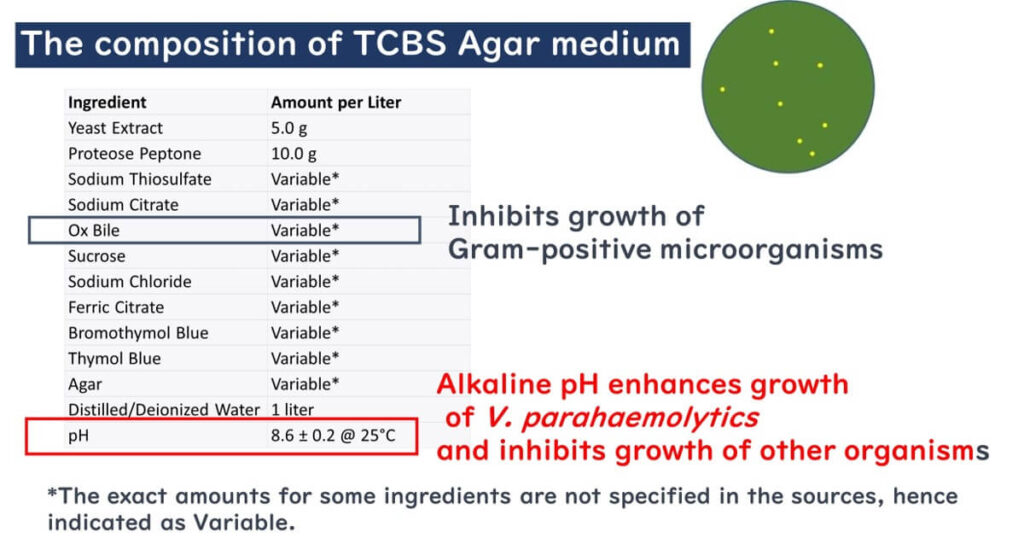
Understanding each characteristic of Vibrio parahaemolyticus, and how one trait leads to the next, helps create a comprehensive picture of this marine bacterium. It’s like watching a row of dominoes fall, each insight building upon the last to illuminate the complex nature of Vibrio parahaemolyticus and its role in foodborne illnesses.
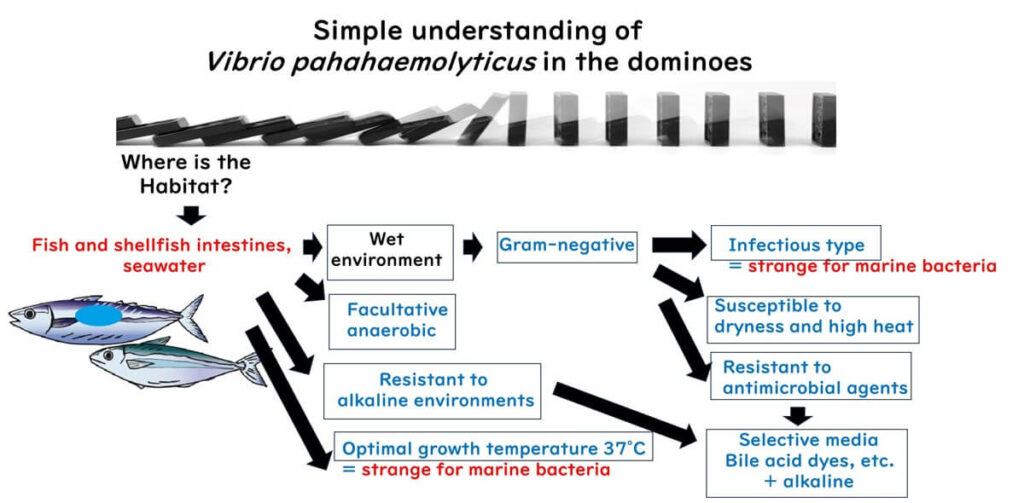
Symptoms and Treatment of Vibrio parahaemolyticus Infection
Ever had seafood and felt unwell afterward? One possible culprit might be Vibrio parahaemolyticus. Symptoms of an infection generally appear about 12 hours after ingestion, though they can range from 8 to 24 hours. Here are the key symptoms to watch for:
- Abdominal Pain and Diarrhoea: These are the primary signs, much like other forms of food poisoning.
- Fever and Vomiting: In more severe cases, fever and vomiting may also accompany the infection.
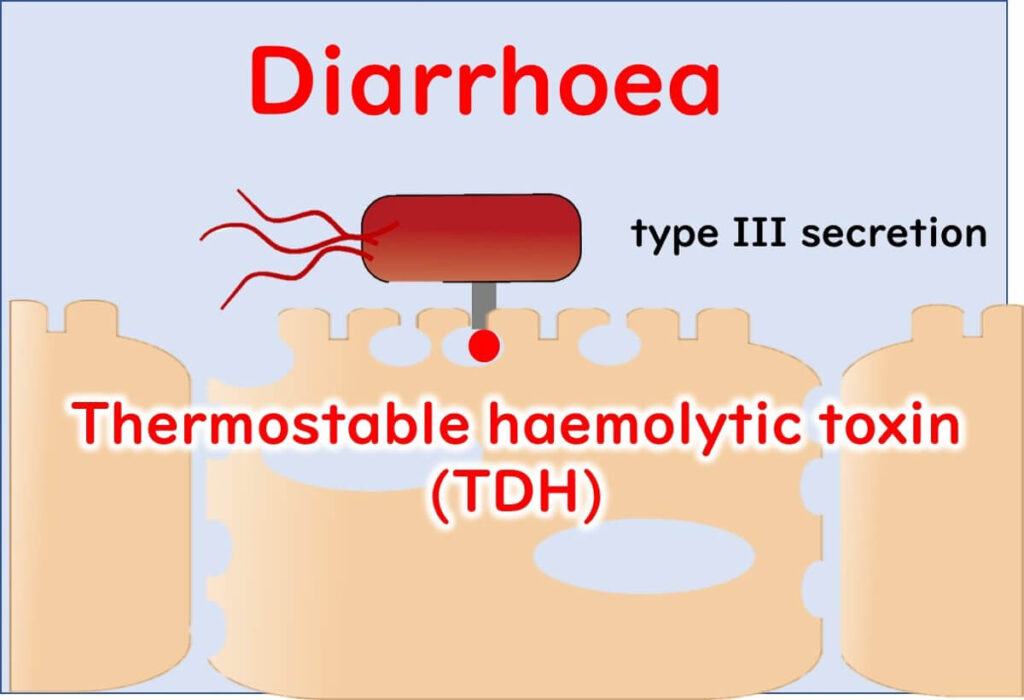
For further insights into incubation periods and the onset patterns of foodborne illnesses, check out our article:
The Extraordinary Relationship between Gram Staining and Microbial Properties
Treatment and Recovery:
The good news is that most people recover from Vibrio parahaemolyticus infections within a few days, often without needing antibiotics. Rest and hydration are generally sufficient to manage symptoms. In rare cases where symptoms persist or worsen, medical intervention may be required.
The Hybrid Nature of Vibrio parahaemolyticus
Vibrio parahaemolyticus is unique among marine bacteria. Known for thriving in seawater due to its need for salt, this bacterium also displays some surprising characteristics that allow it to cause illness in humans. While most marine bacteria wouldn’t typically cause food poisoning in land mammals, Vibrio parahaemolyticus is one of the few exceptions, along with cholera-causing Vibrio cholerae.
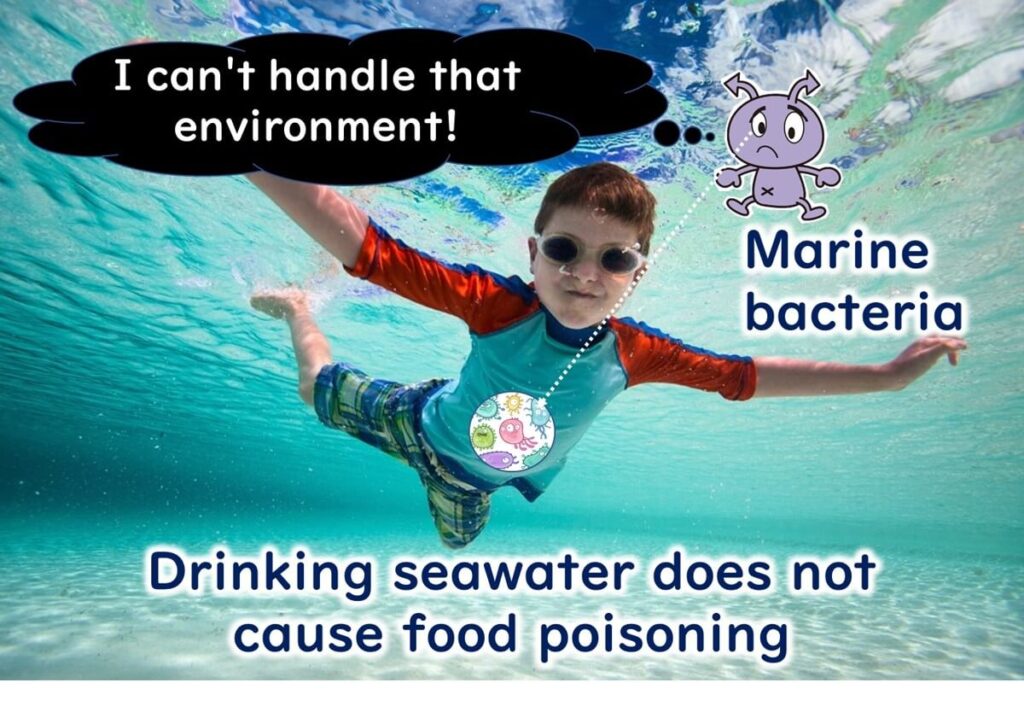
What makes Vibrio parahaemolyticus especially interesting is its ability to adapt to human intestinal environments, even though it originates in the ocean. This bacterium might be on an evolutionary journey, gradually developing the traits needed to infect land mammals. So, while most marine bacteria remain harmless to humans, Vibrio parahaemolyticus stands out as an adaptable outlier capable of thriving in both marine and terrestrial environments.
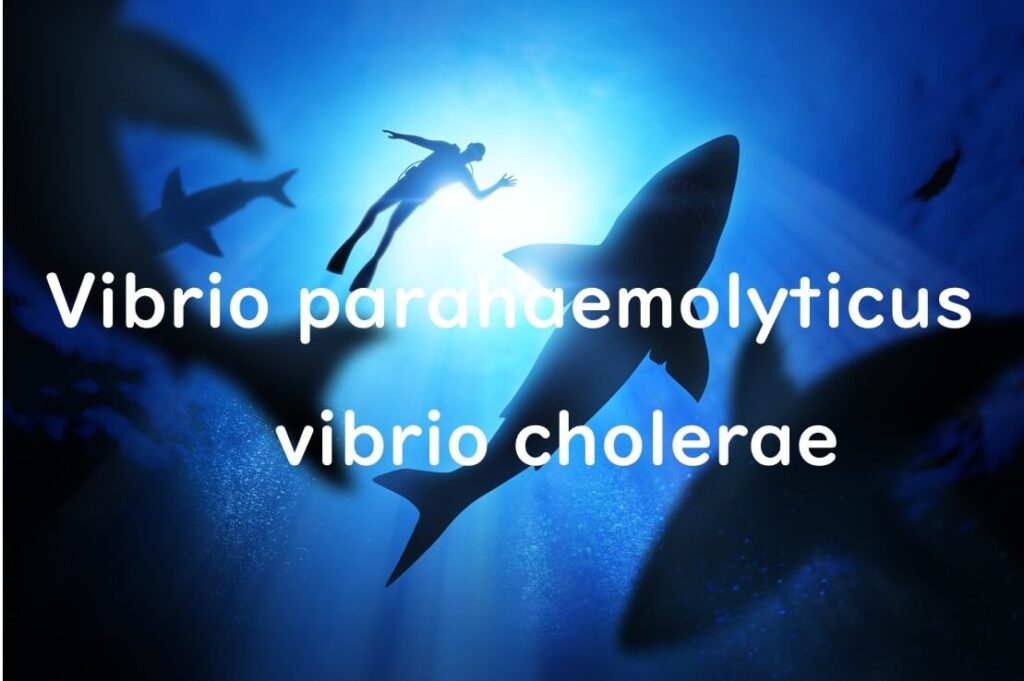
The Mysterious Vibrio parahaemolyticus: Sea Bacterium with Terrestrial Traits
Vibrio parahaemolyticus is not your typical marine bacterium. While it originates from the sea, it displays several surprising traits that allow it to thrive and cause illness in humans. In this section, we explore its hybrid characteristics that blend marine origins with adaptations for survival on land.
Marine Bacteria That Infect Humans
Imagine a world where microbes from the ocean could make us ill. It might seem unlikely, as bacteria that thrive in human intestines—warm, around 37°C—typically come from warm-blooded animals. Common foodborne bacteria like E. coli O157 and Salmonella are well-adapted to these conditions.
However, Vibrio parahaemolyticus, a bacterium from the marine Vibrio genus, defies this expectation. Marine environments and human intestines differ significantly, so we wouldn’t expect marine bacteria to thrive in mammalian guts. Yet Vibrio parahaemolyticus does just that, adapting to infect humans despite its marine origins.
This bacterium is an exception among marine bacteria, with cholera-causing Vibrio cholerae being another rare example. It’s as though Vibrio parahaemolyticus carries a unique “marine signature” while still breaking the rules, thriving in the human body. Scientists speculate that Vibrio parahaemolyticus might be in an evolutionary transition, adapting from a purely marine existence toward infecting land mammals like us. While most marine bacteria remain harmless to humans, this one has chosen a different path.

The Rapid Growth of Marine Bacteria at Mammalian Temperatures
Imagine you're relaxing in a cool pool during summer, but suddenly, you're able to thrive if tossed into a hot tub. Sounds improbable, right? Well, that’s precisely what Vibrio parahaemolyticus, a marine bacterium, does. Typically found in the cool waters alongside fish, Vibrio parahaemolyticus can still reproduce remarkably quickly at the warmer temperatures of 37°C, which is closer to mammalian body temperatures.
Even in summer, seawater rarely exceeds 28°C, and in winter, it averages below 10°C, making this rapid adaptability to warmer temperatures a mystery. At a hot summer room temperature of about 30°C, Vibrio parahaemolyticus divides approximately every 18 minutes, outpacing other foodborne pathogens like E. coli O157 and Salmonella. This rapid replication makes it a formidable competitor in the world of bacteria.

Imagine a slice of sashimi containing around 10 Vibrio parahaemolyticus cells—a typical contamination level. If left at room temperature (30°C) for just three hours, that slice could harbor up to 10,000 cells. If you consume 10 slices, you’re ingesting a staggering 100,000 cells! This ability to multiply so quickly, particularly at room temperature, is what makes Vibrio parahaemolyticus such a risk in raw fish, especially in warm conditions.
What’s more concerning is that Vibrio parahaemolyticus can reach harmful levels before any spoilage odor becomes noticeable. This rapid, stealthy growth is a primary reason food poisoning from raw fish, such as sashimi, can be difficult to prevent. Therefore, ensuring the freshness and proper storage of sashimi and similar seafood is essential for safety.
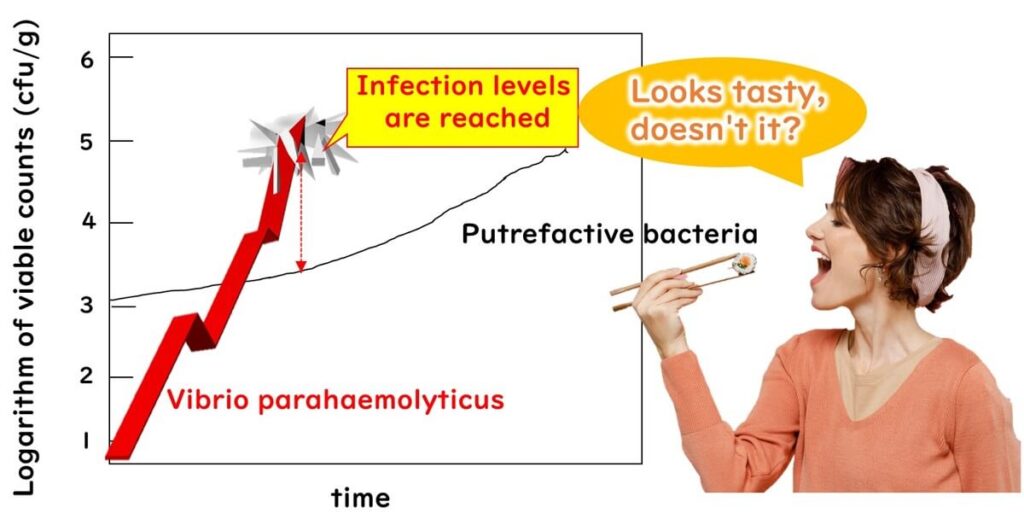
Why Can't This Bacteria Grow in the Fridge?
When we think of marine bacteria, it seems natural to assume they’d be comfortable in colder temperatures, right? However, Vibrio parahaemolyticus is a bit of an outlier—it doesn’t thrive in the cold! Placing it in a refrigerator, where the temperature drops below 10°C, drastically slows its growth.
This is surprising, given that many marine bacteria, including other species in the Vibrio genus, can survive and even grow in colder conditions. In fact, Vibrio parahaemolyticus prefers warmer environments and is most active during summer, which explains why food poisoning cases linked to this bacterium peak during warmer months in Japan.

Interestingly, this temperature preference might have influenced sushi culture in Japan. Imagine if Vibrio parahaemolyticus could grow well in refrigerated conditions—sushi and sashimi consumption could come with much higher food poisoning risks. But thanks to this bacterium’s aversion to cold, storing raw fish at low temperatures helps keep it safe. Next time you enjoy chilled sushi, remember that this bacterium’s unique preference for warmer temperatures is one reason we can enjoy raw fish with peace of mind.
Wash with Freshwater, and It's Gone!
Did you know that Vibrio parahaemolyticus has a surprising weakness? While it thrives in seawater, a simple rinse with freshwater can effectively eliminate it. Freshwater acts almost like kryptonite to this bacterium, swiftly reducing its numbers.
This characteristic is common among many marine bacteria but stands in contrast to land-based bacteria like E. coli, which can tolerate freshwater environments far more easily. Our intestines, for instance, are salty—though not as salty as the sea, with a salinity around 0.85%, similar to a medical saline solution. While Vibrio parahaemolyticus can’t survive in pure freshwater, it’s surprisingly resilient in this slightly salty environment, thriving even faster than E. coli.
This unique preference for moderate salinity shows just how finely tuned Vibrio parahaemolyticus is to its natural habitat, the sea. So next time you think of marine bacteria, remember: they might love saltwater, but a simple freshwater rinse can go a long way in protecting against them!
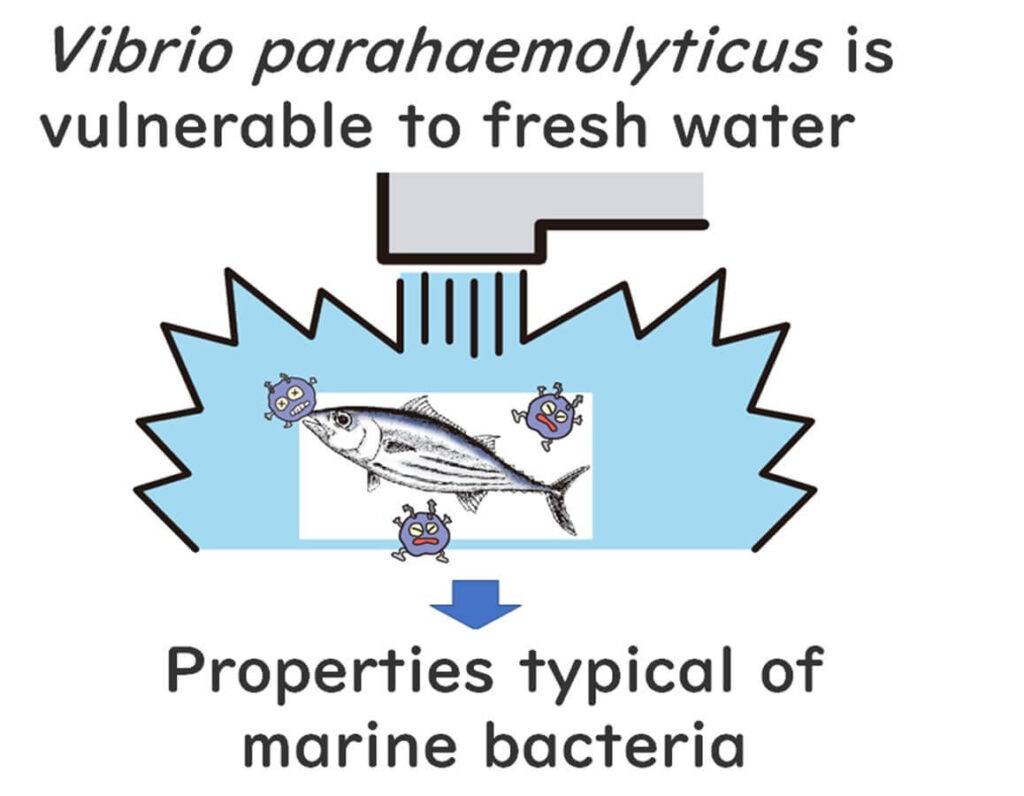
In Japan It Declines, Worldwide It Rises: Intestinal Vibrio Poisoning
It might surprise you to learn that while Vibrio parahaemolyticus-related food poisoning cases have drastically declined in Japan over the past two decades, they have been rising worldwide. This trend contrast is intriguing, especially considering Japan's strong culinary ties to raw seafood, like sushi and sashimi.
Imagine a graph showing two lines: one representing the cases of Vibrio parahaemolyticus food poisoning in Japan from 1996 to 2022, sharply declining, and another depicting the number of global research papers on Vibrio parahaemolyticus over the same period, rising steadily. This visual highlights the significant reduction in cases in Japan, even as global scientific interest in this bacterium has increased.
So why the decline in Japan? In 2000, Japan introduced strict regulations for handling seafood, requiring sterilized seawater or clean drinking water for washing, refrigeration at safe temperatures, and public awareness campaigns. These proactive measures, backed by continuous monitoring, likely contributed to the sharp decrease in Vibrio parahaemolyticus incidents, making raw seafood safer for Japanese consumers.
In contrast, as the popularity of raw seafood spreads internationally, cases of Vibrio parahaemolyticus poisoning have increased outside Japan. This global shift presents an interesting case for researchers aiming to understand how food safety regulations impact the spread of marine bacteria in the context of a growing culinary trend.

The number of Vibrio parahaemolyticus food poisoning outbreaks in the figure above was drawn from data from the Ministry of Health, Labour and Welfare Food Poisoning Statistics. The number of published articles on Vibrio parahaemolyticus was drawn from data surveyed by Scopus.
Why Have Intestinal Vibrio Poisoning Cases Dropped in Japan?
The significant decrease in Vibrio parahaemolyticus poisoning cases in Japan over the past 20 years is both fascinating and informative, especially as cases continue to rise globally. But what led to this decline in Japan?
A 2012 study titled "Characteristics of a sharp decrease in Vibrio parahaemolyticus infections and seafood contamination in Japan", explored this shift, attributing much of the success to regulatory changes implemented in 2000. Here’s a summary of these critical measures:
- Seafood Washing Standards: The regulations mandated that seafood be washed with sterilized seawater, artificial seawater, or drinking water to reduce contamination. Before these rules, approximately 35% of seafood markets in Japan used untreated natural seawater for cleaning, inadvertently increasing contamination risks.
- Strict Storage Temperatures: Originally, 4°C was proposed as the ideal storage temperature for seafood, but due to practical challenges in distribution, the regulation allowed storage at 10°C. While Vibrio parahaemolyticus can still grow at this temperature, it does so at a slower rate, which is acceptable for seafood consumed within 48 hours. However, storing at 4°C is still recommended whenever possible.
- Bacterial Count Guidelines: The acceptable bacterial count for fresh seafood intended for raw consumption was set to no more than 100 MPN/g of Vibrio parahaemolyticus. This threshold, while not exclusively targeting pathogenic strains, serves as a reliable hygiene indicator.
Together, these regulatory steps have substantially lowered Vibrio parahaemolyticus food poisoning cases in Japan, ensuring seafood safety while maintaining a culinary tradition deeply rooted in raw fish consumption. This proactive approach has set a high standard that other countries may look to as Vibrio cases continue to rise worldwide.
Use of Sterilized Seawater, Artificial Seawater, or Drinking Water for Cleaning Seafood
Imagine visiting a seafood market by the coast, watching fish being freshly cleaned and prepared. Before Japan's new guidelines in 2000, around 35% of seafood markets used untreated natural seawater for washing and storing seafood. Surprisingly, nearly two-thirds of these markets didn't employ any sterilization or purification processes. This practice posed a significant risk, as coastal waters often contain high levels of Vibrio parahaemolyticus. Fishermen inadvertently increased contamination risk by rinsing their catch in these untreated waters, even if the fish were originally caught in cleaner, offshore areas.
Recognizing this issue, Japan introduced strict regulations requiring seafood to be washed only with sterilized seawater, artificial seawater, or drinking water. This straightforward yet effective measure aimed to substantially reduce the risk of Vibrio parahaemolyticus contamination, offering consumers safer seafood and setting a high standard for seafood hygiene practices.
Through these changes, Japan successfully curbed contamination risks at a crucial point in the supply chain, demonstrating how targeted, simple interventions can significantly enhance food safety.
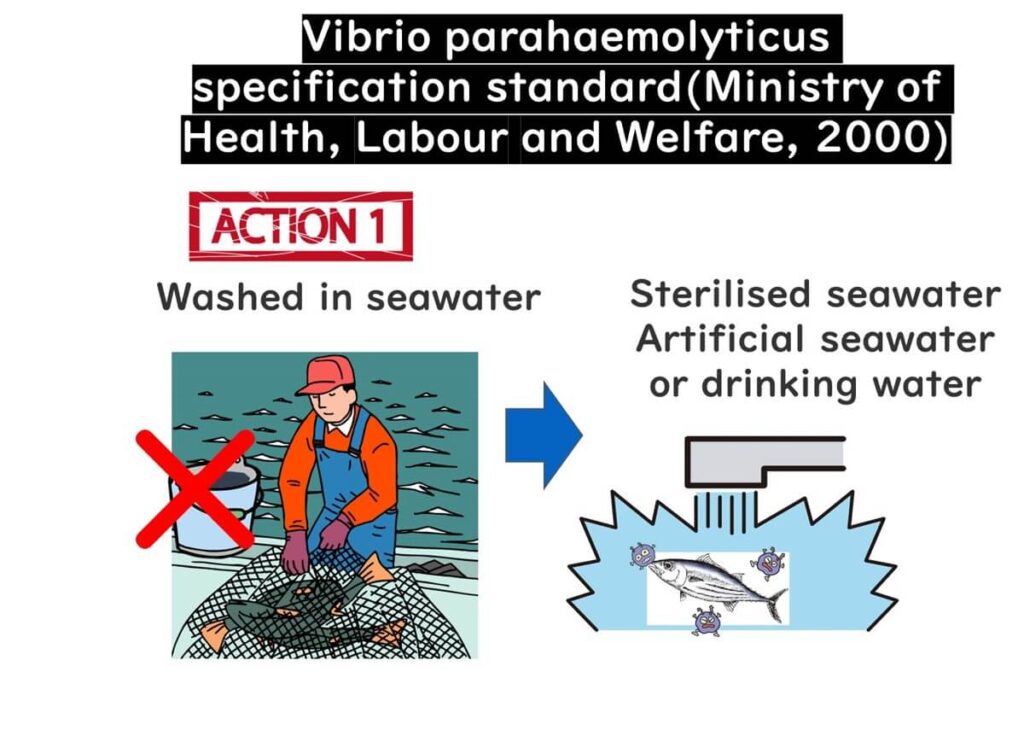
Setting the Storage Temperature for Seafood at 10°C or Below
Picture a discussion between policymakers and seafood industry leaders. Initially, Japan's Ministry of Health, Labour, and Welfare proposed a storage temperature of 4°C for seafood to prevent bacterial growth. While effective for slowing the growth of Vibrio parahaemolyticus, industry representatives argued that consistently maintaining such a low temperature throughout distribution would be challenging.
As a result, the guideline was adjusted to a compromise: seafood should be stored at or below 10°C. This temperature slows the growth of Vibrio parahaemolyticus enough to be safe if consumed within 48 hours. However, the guideline also suggests that 4°C is preferable when feasible, underscoring the importance of lower temperatures for optimal safety.
This flexibility allows for practical implementation across Japan's seafood industry while still prioritizing public health. The careful balance between industry constraints and safety reflects a well-considered approach to minimizing foodborne risks without overly burdening the supply chain.

Using the Count of Vibrio Bacteria in Seafood as a Hygiene Indicator
Imagine you’re at a seafood market, eyeing the fresh fish and wondering about its safety. In Japan, there’s a specific hygiene standard for Vibrio parahaemolyticus levels in seafood to ensure it’s safe for raw consumption. This standard requires that Vibrio parahaemolyticus count must be 100 MPN (Most Probable Number) per gram or less.
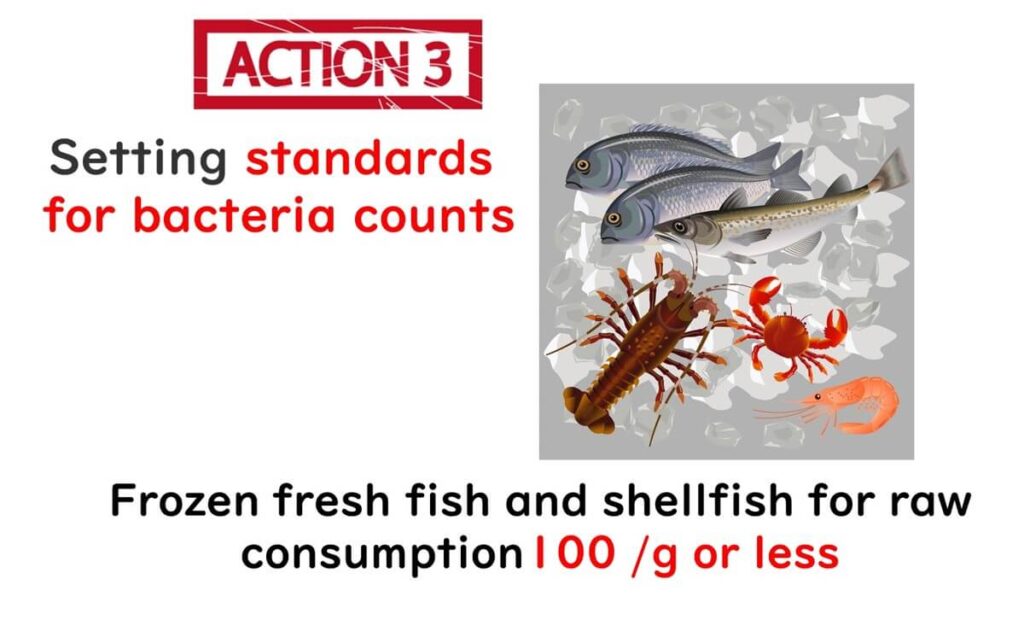
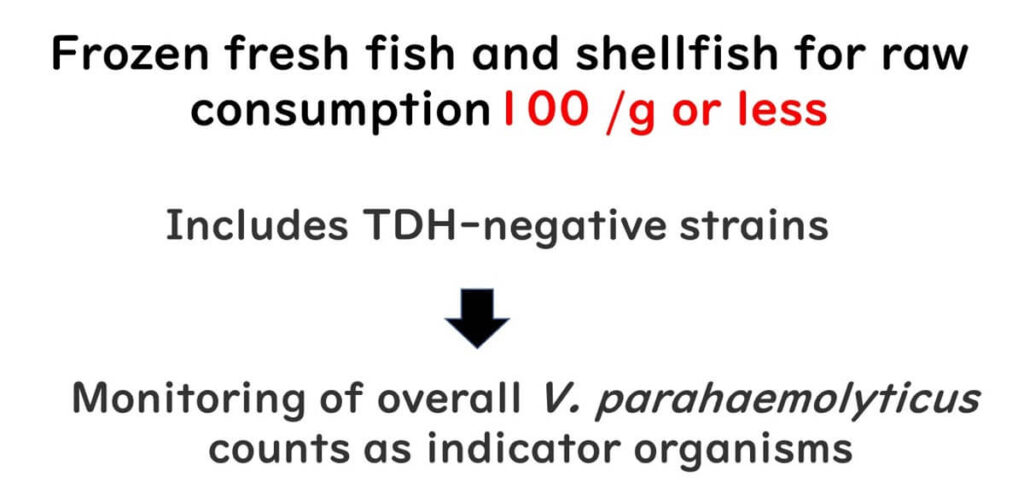
However, this count refers to the general presence of Vibrio parahaemolyticus, not just the harmful strains with the TDH (thermostable direct hemolysin) gene, which can cause severe symptoms. Why monitor all Vibrio levels instead of focusing solely on the pathogenic ones? Research in Japan has shown that the dangerous TDH-positive strains represent only about 1% of the total Vibrio parahaemolyticus population in seafood.

The rare presence of these harmful strains means that general Vibrio parahaemolyticus levels serve as a practical and reliable indicator of hygiene. By keeping overall bacterial levels low, the industry can help ensure seafood safety without needing to identify each specific strain.
This approach offers an effective way to manage food safety, emphasizing control over Vibrio populations to maintain high standards of hygiene for consumers.

